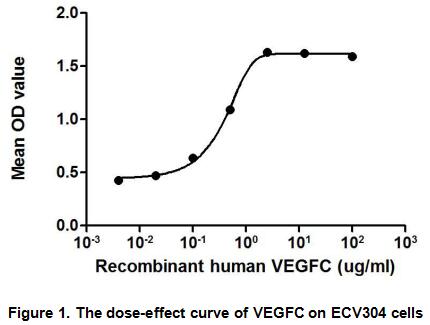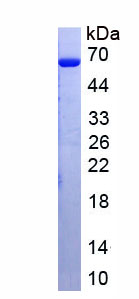Active Vascular Endothelial Growth Factor C (VEGFC) 

VEGF-C; Flt4-L; VRPL; Vascular Endothelial Growth Factor-Related Protein
- UOM
- FOB US$ 211.00 US$ 528.00 US$ 1,056.00 US$ 3,168.00 US$ 7,920.00
- Quantity
Overview
Properties
- Product No.APA145Hu01
- Organism SpeciesHomo sapiens (Human) Same name, Different species.
- ApplicationsCell culture; Activity Assays.
Research use only - DownloadInstruction Manual
- CategoryCytokineTumor immunity
- Buffer FormulationPBS, pH7.4, containing 0.01% SKL, 5% Trehalose.
- Traits Freeze-dried powder, Purity > 90%
- Isoelectric Point8.2
Sign into your account
Share a new citation as an author
Upload your experimental result
Review

Contact us
Please fill in the blank.
Activity test

Vascular endothelial growth factor C (VEGFC) is a protein that is a member of the platelet-derived growth factor/vascular endothelial growth factor (PDGF/VEGF) family. It plays key roles in the physiology and pathology of many aspects of the cardiovascular system, including vasculogenesis, hematopoiesis, angiogenesis and vascular permeability. To test the effect of VEGFC on cell proliferation of ECV304 endothelium cell line, cells were seeded into triplicate wells of 96-well plates at a density of 2,000cells/well and allowed to attach overnight, then the medium was replaced with serum-free standard DMEM prior to the addition of various concentrations of VEGFC. After incubated for 72h, cells were observed by inverted microscope and cell proliferation was measured by Cell Counting Kit-8 (CCK-8). Briefly, 10µL of CCK-8 solution was added to each well of the plate, then measure the absorbance at 450nm using a microplate reader after incubating the plate for 1-4 hours at 37°C. The dose-effect curve of VEGFC was shown in Figure 1. It was obvious that VEGFC significantly promoted cell proliferation of ECV304 cells. The ED50 for this effect is typically 0.304 to 1.339µg/mL.
Usage
Reconstitute in ddH2O to a concentration of 0.1-0.5 mg/mL. Do not vortex.
Storage
Avoid repeated freeze/thaw cycles. Store at 2-8°C for one month. Aliquot and store at -80°C for 12 months.
Stability
The thermal stability is described by the loss rate. The loss rate was determined by accelerated thermal degradation test, that is, incubate the protein at 37°C for 48h, and no obvious degradation and precipitation were observed. The loss rate is less than 5% within the expiration date under appropriate storage condition.
Increment services
-
 BCA Protein Quantification Kit
BCA Protein Quantification Kit
-
 Molecular Mass Marker for Protein
Molecular Mass Marker for Protein
-
 Monoclonal Antibody Customized Service
Monoclonal Antibody Customized Service
-
 Polyclonal Antibody Customized Service
Polyclonal Antibody Customized Service
-
 Protein Activity Test Experiment Service
Protein Activity Test Experiment Service
-
 Electrophoretic Mobility Shift Assay (EMSA) Experiment Service
Electrophoretic Mobility Shift Assay (EMSA) Experiment Service
-
 Buffer
Buffer
-
 Lentivirus Packaging Experiment Service
Lentivirus Packaging Experiment Service
-
 Adenovirus Packaging Experiment Service
Adenovirus Packaging Experiment Service
-
 Real Time PCR Experimental Service
Real Time PCR Experimental Service
-
 Spike RBD Protein (S-RBD)
Spike RBD Protein (S-RBD)
-
 Protein G
Protein G
-
 Protein A
Protein A
Citations
- Alternatively activated RAW264. 7 macrophages enhance tumor lymphangiogenesis in mouse lung adenocarcinomaPubMed: 19241443
- Expression of COX-2 and VEGF-C in cholangiocarcinomas at different clinical and pathological stagesPubMed: 26125824
- Fenofibrate inhibits the expression of VEGFC and VEGFR-3 in retinal pigmental epithelial cells exposed to hypoxiaPubMed: 26622498
- IL-10 Indirectly Regulates Corneal Lymphangiogenesis and Resolution of Inflammation via MacrophagesPubMed: 26608451
- Interleukin-6 Induces Vascular Endothelial Growth Factor-C Expression via Src-FAK-STAT3 Signaling in Lymphatic Endothelial Cells.pubmed:27383632
- RNAi-mediated gene silencing of vascular endothelial growth factor C suppresses growth andinduces apoptosis in mouse breast cancer in vitro and in vivo.pubmed:27895746
- Characterization of isolated liver sinusoidal endothelial cells for liver bioengineeringPubmed:29582235
- Effects of diphyllin as a novel V-ATPase inhibitor on TE-1 and ECA-109 cellsPubmed:29328465
- Dynamic signature of lymphangiogenesis during acute kidney injury and chronic kidney diseasePubmed: 31019289
- Isotretinoin does not alter VEGF-A and VEGF-C levels: Do retinoids behave differently in dose-dependent and/or in vivo/in vitro conditions?Pubmed: 32722957









